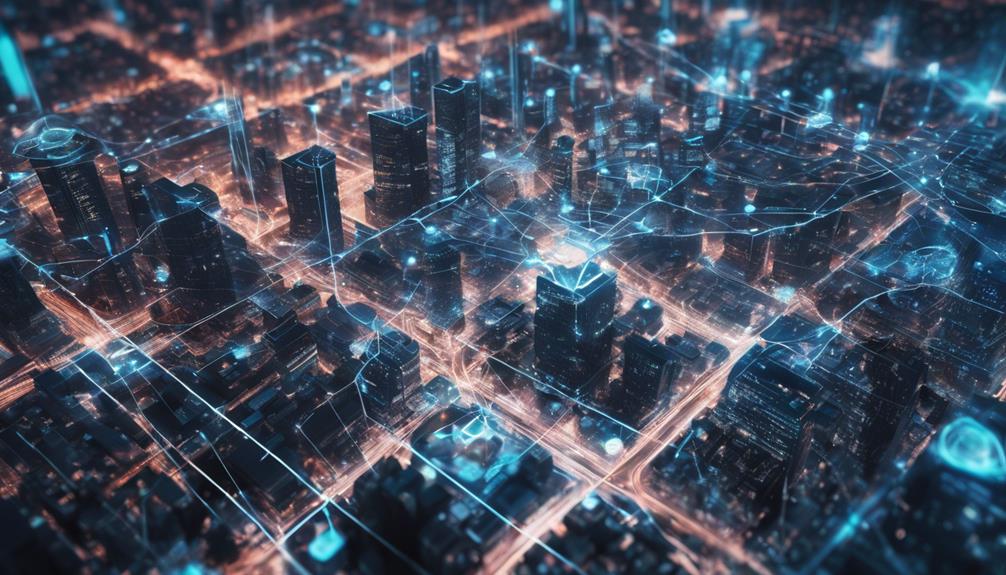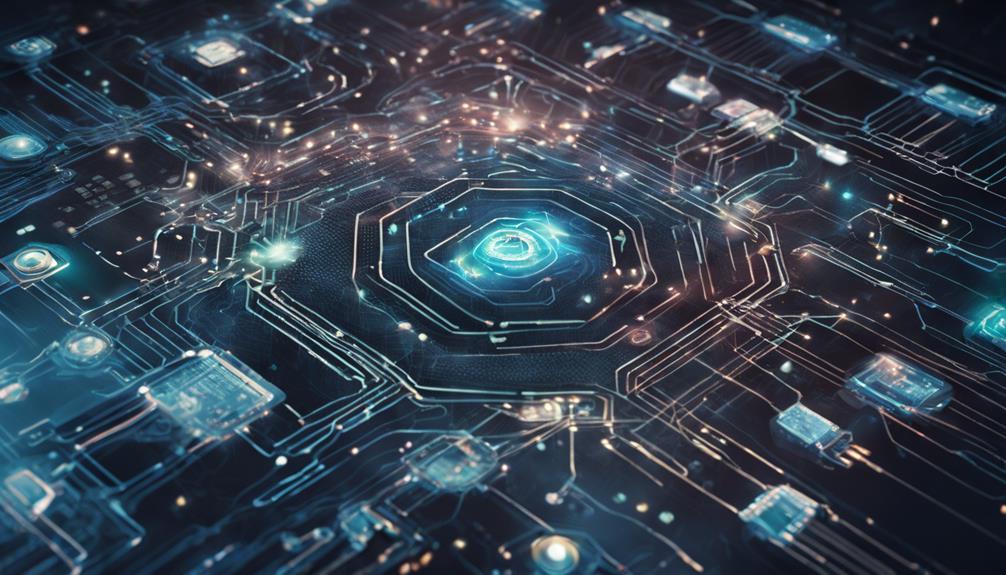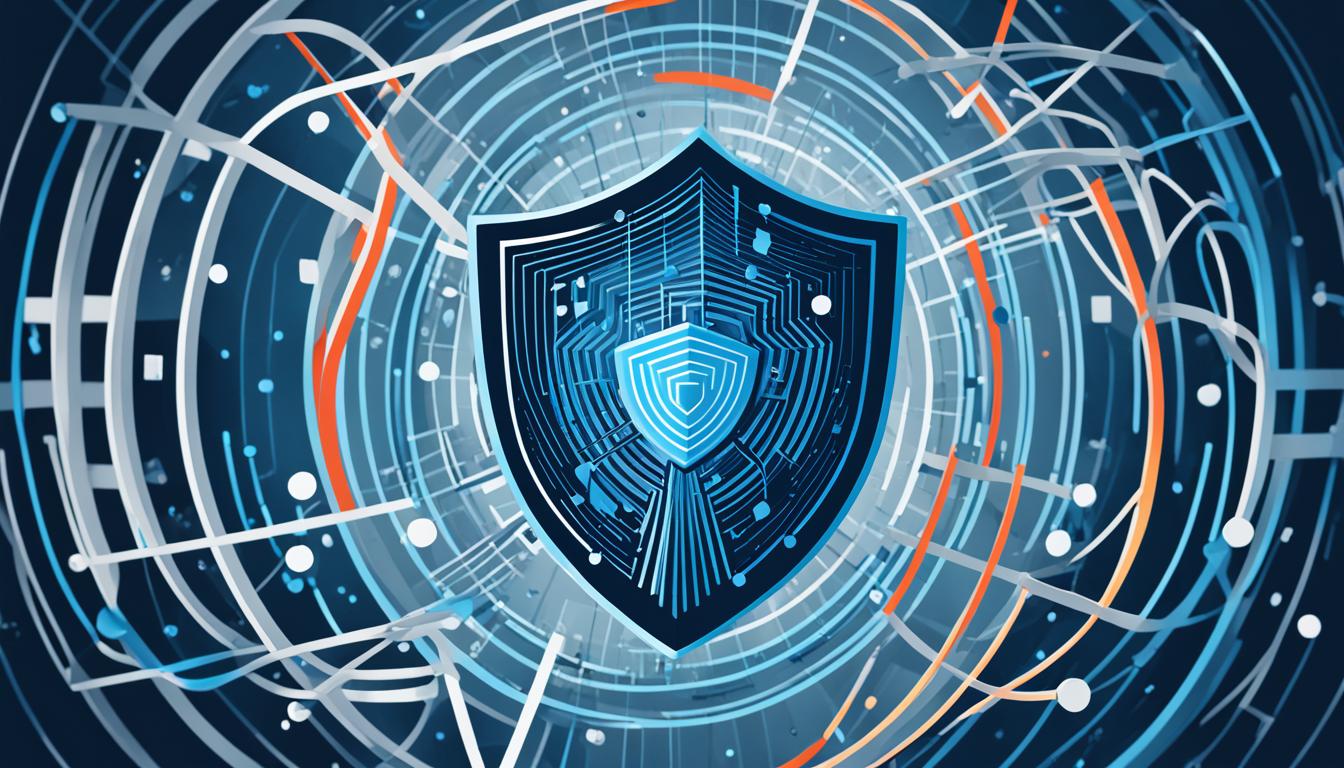AI in Cybersecurity Market is rapidly growing, driven by Machine Learning advancements. The market value is projected to reach USD 163.0 billion by 2033, with a strong 22.3% CAGR. Industries, especially BFSI, are adopting AI for robust security solutions. AI technologies enhance threat detection, automate responses, and fortify defenses. Companies like CrowdStrike and Microsoft engage in AI-focused acquisitions to combat evolving threats. Incorporating AI guarantees compliance with data protection regulations and strengthens defenses. Embracing AI applications is key to staying ahead in the cybersecurity battle. Explore the intricate trends and advancements fueling this dynamic market.
Key Takeaways
- Market projected to reach USD 163.0 billion by 2033 with a 22.3% CAGR.
- AI technologies like Machine Learning driving market growth.
- Investments in cybersecurity escalating, focusing on cloud security solutions.
- Machine Learning dominates market, enhancing defense mechanisms.
- Continuous advancements in AI driving growth in cybersecurity industry.
Market Analysis and Forecast
Indisputably, the market analysis and forecast for AI in cybersecurity present a promising trajectory, with a projected global value of USD 163.0 billion by 2033 and a notable compound annual growth rate (CAGR) of 22.3% from 2024 to 2033.
The growth of the AI in Cybersecurity Market is primarily driven by advancements in AI technologies such as Machine Learning, enabling advanced threat detection capabilities. Investments in cybersecurity are escalating, propelling the market by offering robust solutions for cloud security.
Machine Learning, a key component, dominated the market in 2023, enhancing defense mechanisms and predictive capabilities. Cloud-based solutions, particularly within Managed Services, are experiencing a surge due to their predictive and preventive cybersecurity measures.
The market drivers include improved threat detection, rapid response times, and enhanced compliance with data protection regulations, especially essential in sectors like BFSI. As AI continues to evolve, the market is poised for substantial growth, offering innovative solutions to combat cyber threats effectively.
Industry Adoption of AI

The adoption of AI in cybersecurity is revolutionizing security applications. It enhances threat detection capabilities and paves the way for future growth prospects.
As seen in the BFSI sector's dominant market position and North America's leadership in AI adoption, the industry is recognizing the transformative power of AI in safeguarding digital assets.
With Machine Learning technology leading the charge and Fraud Detection applications making a significant impact, the landscape of AI in cybersecurity is evolving to meet the increasing demands for robust protection against cyber threats.
AI Security Applications
Amid the escalating threat landscape, industries across sectors are increasingly integrating AI security applications to strengthen their cybersecurity defenses. AI plays a pivotal role in proactive threat identification, helping organizations in BFSI, IT & Telecom, Aerospace, and Defense sectors minimize attack surfaces and predict potential threats before they manifest.
The automation of threat identification and response tasks through AI technology is transforming cybersecurity measures, offering advanced capabilities in real-time threat detection. By leveraging AI, ML, and cloud integration, these security applications provide an alternative to traditional solutions, enabling efficient mitigation of cyber threats.
The market growth for AI in cybersecurity is being primarily driven by the rising demand for cutting-edge solutions that enhance security posture and reduce response times. As industries continue to embrace AI security applications, they are better equipped to protect against evolving cyber threats in an increasingly digital landscape.
Impact on Threat Detection
With the increasing demand for bolstering cybersecurity measures, the industry is progressively adopting AI technologies to enhance threat detection capabilities.
AI-driven solutions, leveraging machine learning and behavioral analytics, are at the forefront of revolutionizing threat detection in cybersecurity.
Organizations are turning to these advanced technologies to combat the escalating complexity and frequency of cyber threats effectively. By integrating AI, companies can achieve real-time monitoring, enabling proactive identification of potential risks and swift response mechanisms.
This shift towards AI-powered threat detection is crucial in ensuring a robust cybersecurity posture in the face of evolving cyber threats. The ability to analyze massive amounts of data swiftly and accurately allows for more precise threat detection, response, and prevention.
Embracing AI in cybersecurity not only improves overall security measures but also empowers organizations to stay ahead of threat actors in an increasingly digital landscape.
Future Growth Prospects
Anticipated exponential growth characterizes the industry adoption of AI in cybersecurity, reflecting a strategic shift towards advanced defense mechanisms. Over the forecast period until 2033, the market is set to grow substantially, with a CAGR of 22.3%, showcasing immense growth potential.
Key factors driving this expansion include the increasing use of machine learning algorithms for threat detection, offering organizations enhanced security operations. To paint a picture of the industry's future, consider the following:
- Escalating Demand: Organizations across various sectors are increasingly recognizing the value of AI cybersecurity solutions, fueling the market growth.
- Advanced Security: AI technologies are revolutionizing security measures by providing predictive capabilities and real-time threat detection, ensuring proactive defense mechanisms.
- Market Expansion: With services playing a pivotal role in the AI in cybersecurity market, specialized expertise and continuous monitoring services are projected to witness substantial demand, further driving market growth.
Embrace the evolving landscape of AI in cybersecurity to fortify your organization's defenses and stay ahead of emerging threats.
Investment Trends in Cybersecurity

The landscape of cybersecurity investments is dynamic, with funding pouring into AI-driven solutions. Venture capital is showing keen interest, and technology acquisitions are rapidly evolving.
As the industry witnesses a surge in financial support, the focus is shifting towards innovative approaches that leverage AI technologies to enhance security measures.
Understanding these investment trends is vital for staying abreast of the latest developments in cybersecurity and harnessing the potential of emerging technologies to fortify digital defenses effectively.
Funding in Cybersecurity
Investment trends in cybersecurity have shown a significant increase in funding, with a total of $10.4 billion invested in 2020, marking a 14% growth from the previous year. This surge in funding demonstrates the growing confidence in the industry's market potential and innovation.
The record-high funding for cybersecurity startups in 2021, reaching $7.8 billion, indicates a strong interest from investors in supporting new ventures within this sector.
To paint a clearer picture of the funding landscape in cybersecurity, consider the following:
- Venture capital funding in cybersecurity startups skyrocketed by 160% in Q2 2021 compared to the previous year, showcasing the attractiveness of this sector to investors.
- Major investors such as Accel, Sequoia Capital, and Bessemer Venture Partners have been actively supporting cybersecurity companies, contributing to the industry's growth and development.
- Prominent cybersecurity firms like SentinelOne, Snyk, and Lacework have emerged as top recipients of funding, reflecting the market's potential for continued expansion and cutting-edge innovation.
Venture Capital Investments
A surge in venture capital funding has propelled the cybersecurity sector to new heights, reflecting a robust interest from investors in innovative solutions and technologies.
In 2021, venture capital investments in cybersecurity reached a record high of $7.8 billion, with over 1,500 deals globally. Early-stage cybersecurity startups are particularly benefitting from this trend, receiving significant funding to develop groundbreaking technologies such as AI and ML.
Investors are showing a keen interest in startups focusing on cloud security, zero-trust architecture, and threat intelligence solutions, recognizing the importance of staying ahead of evolving cyber threats.
Venture capital firms are actively supporting cybersecurity companies in their mission to address the escalating challenges posed by cyber threats and data breaches. This influx of funding not only drives innovation within the industry but also underscores the growing significance of cybersecurity in today's digital landscape.
Emerging Technology Acquisitions
Amidst the escalating venture capital investments in cybersecurity startups, a notable trend shaping the industry is the surge in acquisitions of emerging technologies, particularly focused on bolstering AI capabilities and enhancing cyber defense offerings. This strategic move aims to stay ahead in the cybersecurity landscape and provide advanced solutions to combat evolving threats.
Here are some key points to take into account:
- Strategic Acquisitions: Companies like CrowdStrike, Palo Alto Networks, and Microsoft are actively engaging in mergers and acquisitions to strengthen their portfolios in AI-driven threat detection, cloud security, and behavioral analytics.
- Focus on AI Capabilities: The acquisitions are geared towards enhancing AI capabilities within cybersecurity solutions to improve threat detection and response mechanisms.
- Enhanced Cyber Defense Offerings: By integrating these emerging technologies, organizations can offer more robust cyber defense offerings to protect against sophisticated cyber threats and breaches effectively.
Threat Detection Technologies

Threat detection technologies, such as Machine Learning (ML), Natural Language Processing (NLP), and Context-Aware Computing, are pivotal components in the domain of AI cybersecurity, offering advanced capabilities for identifying and responding to cyber threats.
In 2023, Machine Learning emerged as a dominant force in the market, providing predictive capabilities that enable organizations to proactively combat security risks. Natural Language Processing applications are instrumental in analyzing human language to detect potential threats, while Context-Aware Computing enhances the detection process by considering contextual information.
These technologies not only improve response times to cybersecurity incidents but also aid in compliance with data protection regulations. By leveraging these innovative tools, organizations can effectively safeguard their systems against complex cyber threats, ensuring a robust security posture.
Embracing these technologies equips businesses with the necessary arsenal to stay ahead of malicious actors and protect sensitive information from potential breaches.
Compliance and Data Protection
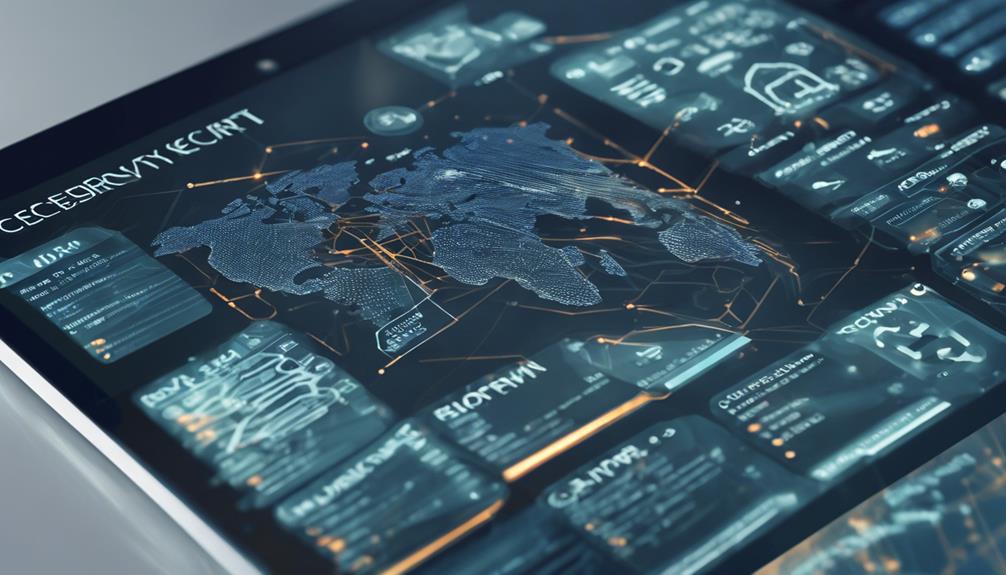
Ensuring compliance with data protection regulations through the integration of AI technology has become a critical focus for organizations seeking to safeguard sensitive information in an increasingly digital landscape.
Here are key aspects highlighting the intersection of compliance and data protection with AI technology:
- AI-driven Compliance: AI assists organizations in adhering to stringent compliance regulations such as GDPR and CCPA by automating data protection processes and ensuring data privacy.
- Enhanced Data Security: Integration of AI enables data encryption and anonymization techniques, strengthening data protection measures against potential breaches and unauthorized access.
- Proactive Compliance Measures: AI algorithms play a pivotal role in identifying and mitigating data breaches in real-time, helping organizations maintain compliance standards and respond swiftly to security incidents.
Importance of AI in Defenses

The importance of incorporating AI technology in cybersecurity defenses cannot be underestimated. AI in cybersecurity is crucial for enhancing defense mechanisms against sophisticated cyber threats. Machine learning (ML) stands out as a dominant technology within AI cybersecurity, offering predictive capabilities and advanced threat detection.
Organizations are increasingly turning to AI applications for tasks like malware detection, user behavior analytics, and fortifying overall security measures. By leveraging AI in cybersecurity, businesses can greatly improve response times, guarantee compliance with data protection laws, and elevate their security posture.
The integration of behavioral analytics, automated security systems, and AI-driven defense strategies represents the evolving landscape of cybersecurity. These developments showcase the critical role that AI plays in fortifying defenses, enabling proactive threat mitigation, and reinforcing organizations' resilience against emerging cyber risks.
Embracing AI in cybersecurity not only enhances protection but also empowers businesses to stay ahead in the ever-evolving cybersecurity landscape.
Mitigating Cyber Risks

In the domain of cybersecurity, the thorough mitigation of cyber risks hinges on the strategic integration of AI-driven technologies. AI in security plays a pivotal role in proactively identifying and responding to threats, leveraging machine learning models to enhance cybersecurity measures.
To paint a detailed picture for the audience:
- Automating Threat Detection: AI-based cybersecurity solutions automate the detection of potential threats in real-time, enabling swift responses to mitigate risks effectively.
- Enhancing Cybersecurity Defenses: Machine learning algorithms analyze vast datasets to anticipate and prevent evolving cyber threats, thereby strengthening overall cybersecurity posture.
- Adaptive Security Measures: AI facilitates adaptive security measures that protect digital assets and critical systems by continuously monitoring and adjusting defenses to combat sophisticated cyber threats.
Sophisticated Threat Landscape

As cyber threats continue to evolve in complexity and frequency, the cybersecurity landscape is faced with unprecedented challenges. The rise of ransomware, phishing attempts, insider cyber threats, and targeted attacks has created a sophisticated threat landscape that organizations must navigate.
In response, the adoption of AI in cybersecurity has become essential for enhancing threat detection and response capabilities. AI solutions provide proactive and adaptive security measures to safeguard digital assets and critical systems from malicious intrusions.
Enhancing Security Measures
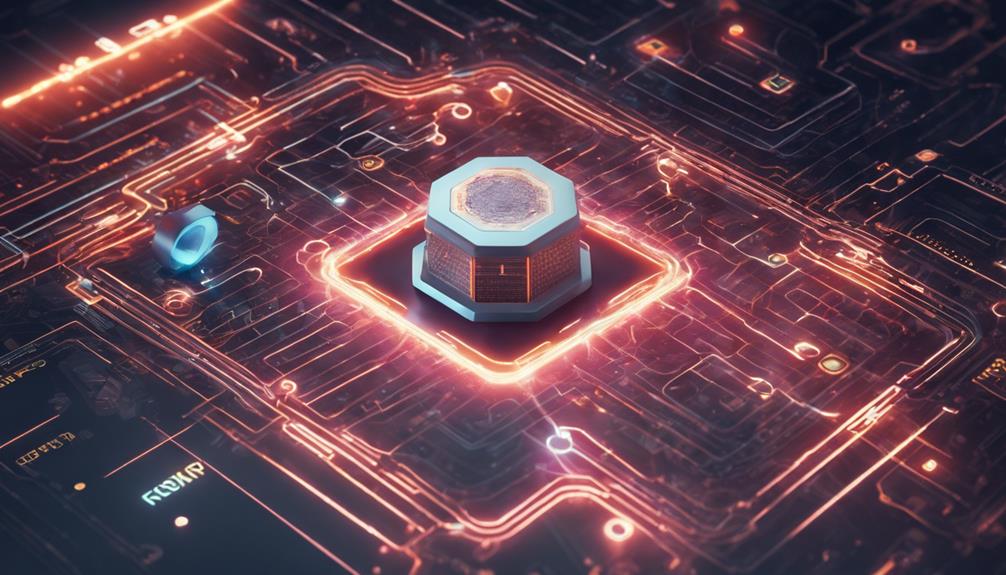
AI in cybersecurity is revolutionizing security measures by enhancing threat detection capabilities through predictive Machine Learning algorithms.
Automated response strategies and real-time monitoring solutions are key components in bolstering defenses against evolving cyber threats.
Implementing these advanced technologies guarantees proactive protection and swift responses to potential security breaches, fortifying overall cybersecurity resilience.
Threat Detection Capabilities
Enhancing security measures through advanced threat detection capabilities is a critical aspect of leveraging AI in cybersecurity.
Here are three key ways in which AI enhances threat detection capabilities:
- Machine Learning Algorithms:
AI in cybersecurity enables the use of machine learning algorithms to sift through massive datasets swiftly. This proactive approach aids in identifying potential security threats before they escalate.
- Real-Time Monitoring:
AI allows for real-time monitoring and analysis of network activities. This capability enables immediate responses to suspicious behavior and potential cyberattacks, enhancing overall security posture.
- Adaptability to New Threats:
AI-driven threat detection systems can adapt and evolve to new and emerging security threats. By continuously learning and improving over time, these systems offer organizations a dynamic and robust defense against evolving cybersecurity challenges.
Automated Response Strategies
Leveraging automated response strategies plays a pivotal role in fortifying cybersecurity measures by enabling swift and proactive actions against potential threats. Automated response systems utilize machine learning algorithms to facilitate real-time threat detection, allowing for immediate action when cyber threats are identified. By automating incident response tasks, these systems greatly reduce response times, enhancing the organization's ability to mount a rapid defense. Proactive defense is achieved through continuous monitoring of network activities, enabling the system to swiftly identify and neutralize potential threats, thereby mitigating risks effectively. The integration of AI-driven automation in cybersecurity not only bolsters defenses but also strengthens the overall cybersecurity posture of organizations. Below is a table summarizing the key aspects of automated response strategies in cybersecurity:
| Key Aspect | Description |
|---|---|
| Real-time threat detection | Utilizes machine learning algorithms for immediate threat identification |
| Immediate action | Enables swift responses to cyber threats |
| Proactive defense | Automates incident response tasks to defend against attacks |
| Reduce response times | Speeds up the reaction time to security incidents |
| Mitigating risks | Continuously monitors network activities to neutralize threats |
Real-Time Monitoring Solutions
Real-time monitoring solutions play a pivotal role in bolstering cybersecurity measures by providing immediate threat detection and response capabilities. These solutions leverage AI algorithms to continuously scrutinize network activities for potential security breaches.
Here are three essential aspects of real-time monitoring solutions:
- Essential Monitoring: Real-time monitoring solutions enable proactive surveillance of network activities, swiftly identifying and addressing any suspicious behavior. This proactive approach helps in detecting and neutralizing cyber threats before they pose serious risks to digital assets.
- Immediate Alerting: By utilizing AI algorithms, these solutions can swiftly alert cybersecurity teams about any potential security breaches or anomalies in network behavior. This rapid notification mechanism allows for quick response and mitigation of security incidents before they escalate into major crises.
- Improved Security Measures: Real-time monitoring solutions significantly enhance security measures by providing continuous monitoring and analysis of network activities. This continuous vigilance is essential in safeguarding digital assets against evolving cyber threats and ensuring robust cybersecurity defenses.
AI Applications in Cybersecurity

AI applications in cybersecurity harness advanced technologies like machine learning, natural language processing (NLP), and context-aware computing to strengthen defenses against cyber threats.
Machine learning, a dominant force in this field, empowers AI systems with predictive capabilities and enhances defense mechanisms. Particularly important is the role of AI in fraud detection, where its sophisticated algorithms help combat the rising complexity of cyber threats.
Additionally, AI in cybersecurity greatly improves threat detection accuracy, response times, and guarantees compliance with data protection regulations, a vital aspect, especially for sectors like BFSI.
Services within the AI in cybersecurity market hold a substantial share, exceeding 35%, reflecting the increasing demand for specialized expertise and continuous monitoring to safeguard against evolving cyber risks.
Embracing AI applications in cybersecurity not only fortifies defenses but also enables organizations to stay ahead in the relentless battle against cyber threats, ensuring a more secure digital landscape for all.
Frequently Asked Questions
How Big Is the AI Cybersecurity Market?
The AI in cybersecurity market is significant, valued at USD 22.4 billion in 2023 and projected to reach $60.6 billion by 2028 with a CAGR of 21.9%. Rapid growth is fueled by the increasing adoption of real-time threat detection solutions.
How Is AI Being Used in Cybersecurity?
In the field of cybersecurity, AI serves as a force multiplier, offering predictive threat intelligence, real-time detection, and adaptive defense strategies. Harnessing sophisticated algorithms, AI empowers experts to enhance security postures and safeguard critical digital infrastructures.
What Is the Market Trends of Artificial Intelligence Industry?
The market trends of the artificial intelligence industry are characterized by rapid growth, increasing adoption across various sectors, advancements in machine learning algorithms, rising demand for automation, and a focus on developing AI-driven solutions that enhance operational efficiency and decision-making processes.
What Is the Market Growth for Cybersecurity?
In the domain of cybersecurity, growth is burgeoning like a mighty oak tree, expanding its reach and fortifying defenses. With an anticipated surge, the market is poised to soar, offering innovative solutions to combat evolving threats.
Conclusion
In summary, the growth of AI in the cybersecurity market is undeniable, with increasing industry adoption and investment trends. While some may question the effectiveness of AI in mitigating cyber risks, it is important to acknowledge the advancements in threat detection technologies and compliance measures.
By leveraging AI applications in cybersecurity, organizations can enhance their security measures and better protect against the sophisticated threat landscape. It is essential to embrace these advancements to stay ahead of cyber threats.
